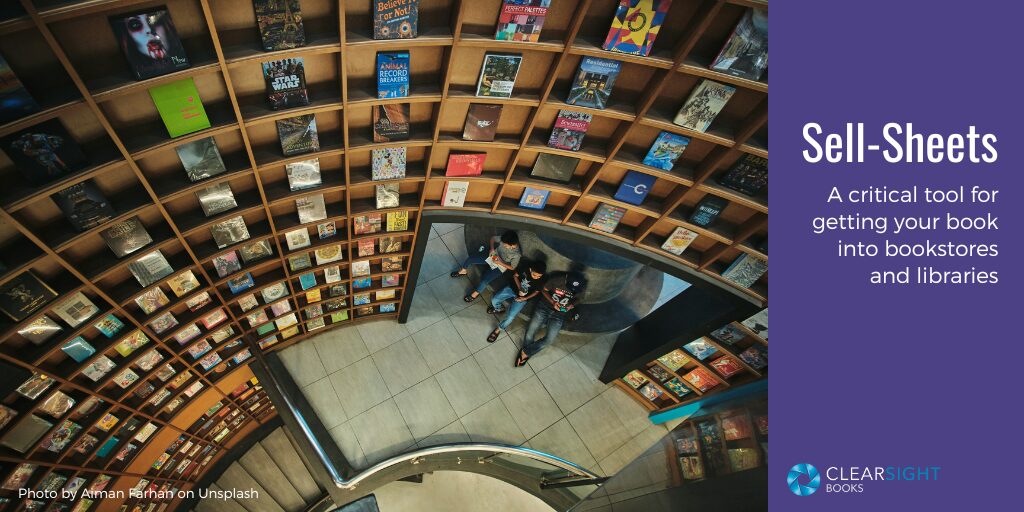
Many indie authors focus their marketing efforts on online sales, but some are interested in getting their book into brick-and-mortar bookstores and libraries. If that’s you, a “sell-sheet” may help.
What Is a Book Sell-Sheet?
A sell-sheet is just what it sounds like: a one-pager that sells your book. It provides basic information that helps stores and libraries decide if your book is a good fit for them.
If you’ve been in the professional speaking world, you might have used a similar “one-sheet” to extol your professional virtues: your speaking topics, experience, and audience feedback. When I was a business consultant, I used a similar document that listed my background, my consulting focus, and comments from clients who had worked with me.
Essentially you are making a mini-resume for your book. Why should a library or store “hire” your book?
What Does a Book Sell-Sheet Include?
Sell-sheets should include some critical info, but there is some optional info to consider as well.
The basics
At minimum, include the following:
- Book cover – Books are judged by their covers, so definitely include at least a thumbnail of yours. If your cover wows people, you might make it a bigger component of the design.
- Book description – This is usually your cover copy. It should provide a succinct but compelling description of your book.
- Author bio – Your bio should concisely demonstrate your credibility for writing the book. It is probably the bio from your cover copy. An author photo is optional.
- Core book info – For each format (hardback, paperback), provide the ISBN, retail price, page count, trim size, publisher, and publication date.
- Purchase info – Include info on how your book can be purchased. If it is available via Ingram (because you are publishing via IngramSpark), indicate that; if you use a distributor, indicate that. If there are bulk discounts available, provide contact info for inquiries.
- Contact info – If the bookstore or library has questions, make sure they know who to contact, whether it’s you, your publisher, or your PR person.
The extras
It may be useful to include the following extras, if you have them:
- Comps – Including competitive and comparable titles can help stores and libraries understand where your book fits into the market and what readers might be interested.
- Endorsements and awards – If you have endorsements, especially notable ones, include some of the best. If you’ve won awards, include those as well.
- Audience – You may include a statement about who the book will appeal to and why, though this may already be evident from your book description.
- Prior books – Sometimes it can be useful to show your track record with other books (kind of like the “Also by Author Name” list you sometimes see at the beginning of books).
- Additional info – You might include links to available marketing tools (e.g., social media graphics), additional resources (e.g., a book club discussion guide), or specific marketing activities you have planned (e.g., an upcoming event).
Sell-sheets can be fairly straightforward in terms of design (say, designed in Word) or fancier (created by a professional graphic designer). As you might imagine, a professional design may have a stronger visual impact, but don’t let lack of it stop you from moving ahead.
Sample Book Sell-Sheets
Here are two examples of sell-sheets: one for Ann Marie Sabath’s nonfiction book The Wannabe Investor and one for my very own Chicken Haiku.
You can also search online for “book sell sheet” and find plenty of examples and templates.
Beyond Bookstores
Having a sell-sheet is no guarantee you will get your book into brick-and-mortar bookstores or libraries. With limited shelf space, buyers still have to be choosy. And, your book must be professional quality: a colorful sell-sheet won’t overcome a poorly written or produced book.
But there are benefits to having a sell-sheet besides using it to sell books. Pre-publication, you can start writing it to help you clarify your selling point and position your book more strategically. Post-publication, you can attach your sell-sheet to press releases or use it as part of speaking or consulting proposals.
And you might just find that you get a little emotional perk from having a sell-sheet. When you’ve got a professional PR piece that sings your book’s praises, you don’t have to be quite so bashful “bragging” about it yourself.
Need help assessing if your book is ready for prime time? Contact me at karin@clearsightbooks.com and let’s chat!

